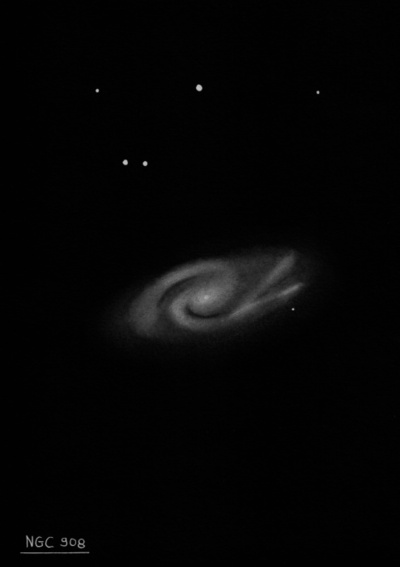
William Herschel discovered NGC 908 = H I-153 on 20 Sep 1786 (sweep 596) and noted "cB, vL, E from sp to nf, I believe above 15' long; but the ends are very faint." His position (CH's reduction) is accurate. John Herschel made no observations of this galaxy either from Slough or the Cape. The NGC position is accurate.
200/250mm - 8" fairly bright, large, elongated E-W.
400/500mm - 17.5" (12/4/93): fairly bright, large, elongated 4.5'x2.0' WSW-ENE. The brighter middle has an irregular surface brightness and a faint star or knot is just west of the geometric center [this is probably the nucleus]. A mag 14 star is just south of the following end. Four mag 11-12.5 stars lie 3' to 5' N and form a trapezoid with parallel bases oriented E-W.
900/1200mm - 48" (10/27/19): at 375x; Showpiece two-armed spiral extending 5'x2' WSW-ESE and displaying a great deal of structure. Contains a bright oval core with a very small, very bright nucleus. A knotty spiral arm is rooted at the northeast end of the core. It bends sharply to the west on the north side of the core and displays a blotchy surface. As this arm extended west it separated from an inner arm by a dark lane, spread out and faded at the west end.
A longer spiral arm emerges from the west side of the core. It wraps tightly to the east in a bright arc to the south of the core. This arm has a fairly well defined outer edge, but was not as splotchy as the northern arm. At the east end, it splits into two arms with a slightly darker gap between and passes north of a mag 14.4 star. The northern split arm has a brighter 15" patch at its tip [1.0' NNW of the mag 14.4 star].
Notes by Steve Gottlieb